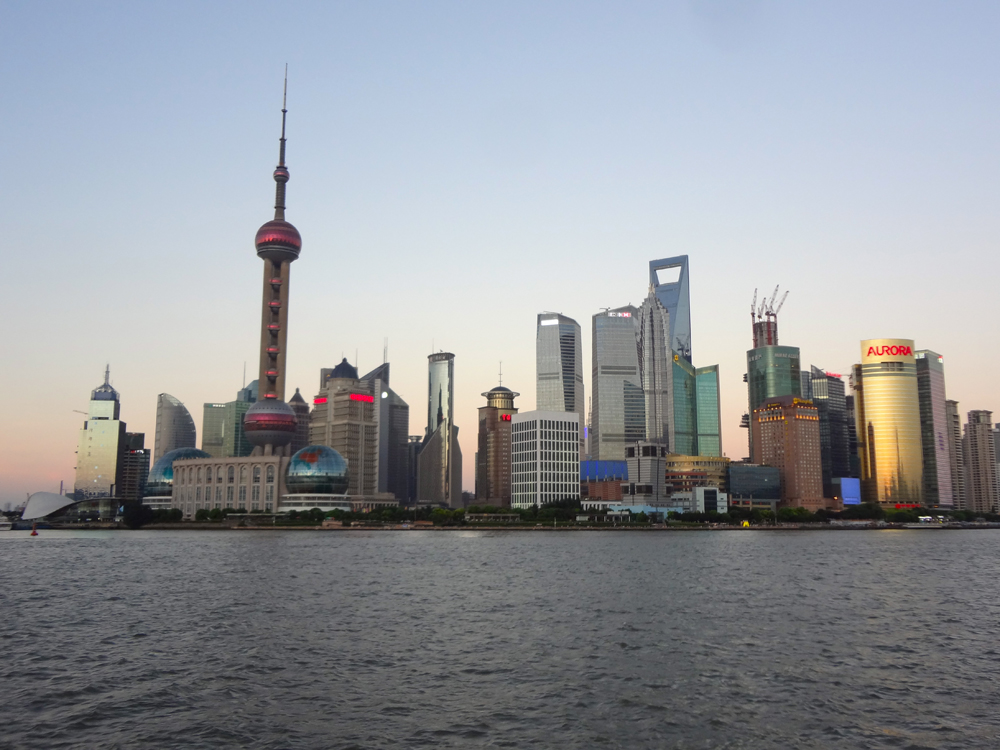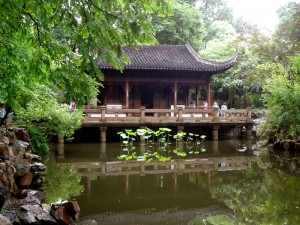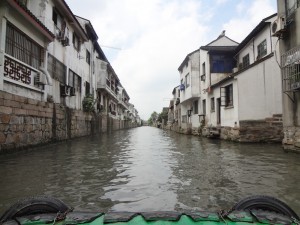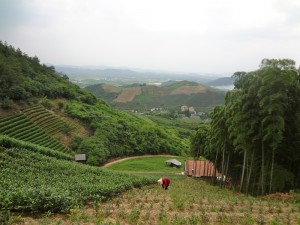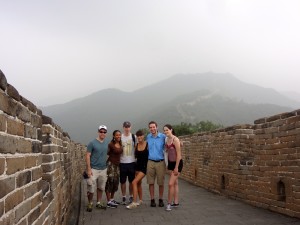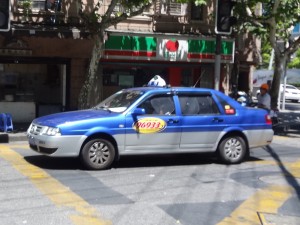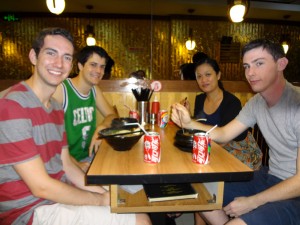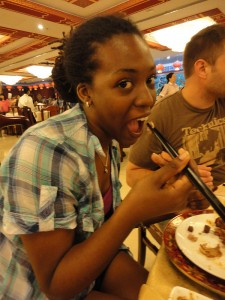I wanted to highlight some places in the Tuscan region that tourists should visit that are “off the beaten path.” Here are just a few:
Tarot Garden
Nikkie de Saint Phalle created the Tarot Garden tirelessly working towards her passion from 1979 – 1996. She created a tarot garden depicting the 22 tarot cards in an old stone quarry in Maremma. She even lived in one of her creations while building others. The 22 figures consist of sculptures, architecture, and monuments. Phalle directed a team of artists to create these remarkable figures of concrete, mosaics, and ceramics. Some of the larger figures include The Empress, The Magician, and The High Priest. The monumental sculptures were made from welded steel bars. Phalle’s idea of a monumental sculpture park was influenced by Gaudi’s Parc Guell in Barcelona.
One of the most impressive sculptures of the garden was The Empress which represents a sphinx. The Empress is the great goddess. Phalle and her husband Jean Tinguely even lived in this monument while building others. Phalle also used The Empress for meetings and coffee breaks with her crew. Phalle describes her as the “Queen of the sky. Mother. Whore. Emotion. Sacred magic and civilization.
Maremma and Bolgheri
Maremma is one of the most visited tourist areas of the Tuscan area bordered by the Tyrrhenian and Ligurian Seas. Many different vineyards are found in Maremma making some of the finest wines known world-wide. Bolgheri is located in Northen Maremma which produces Bordeaux wine varieties such as Cabernets, Merlot, and Petit Verdot which thrive in high temperatures. Bolgheri also grows Rhone grapes such as Syrah.
Marble quarries of Carrara
Carrara is located in a commune in the Tuscan region in a the Province of Massa and Carrara. Carrara is noted for it’s white and grey-ish marble. Carrara marble has been used for many centuries. It dates back to it’s use in The Pantheon and Trajan’s Column in Rome. The Carrara marble is exported all around the world. The marble is extracted from the mountainsides of the Apuan Alps. Due to excessive mining, the marble from this area poses a risk of almost being extinct.
Marble in Carrarra began over 200 million years ago when skeletal remains of shellfish and other creatures formed limestone sediment on the deep sea floor. As continents began to shift and collide, mountains formed and created white marble. The marble was bought to the surface of the Apuan Alps.
Viareggio
Another Tuscan city is Viareggio, which located in northern Tuscany on the coast of the Tyrrhenian Sea. It is also known as Versilia and is the second largest city in the Province of Lucca. Viareggio is home to the Carnival of Viareggio which features large paper-mache floats. Carnival of Viareggio is considered one of the most important carnival celebrations in Europe. This carnival dates back 1873 and often features floats dedicated to current political satire. The carnival takes place in the weeks before Easter. The craftsmen build their famous floats in Cittadella del Carnivale all year long. From the very beginning, the carnival was dedicated to politics. In 1873, a wealthy man organized a parade of floats with flowers. Local citizen protested the parade by wearing masks showing their refusal to pay higher taxes for the carnival.
These are just a few suggestions for your Tuscan tour guide. Enjoy! Ciao!
Monthly Archives: August 2012
Rome Tour Guide
Rome, Italy is an iconic city with great historical events and locations. Rome is home to many ancient artifacts, culture, architecture, and engineering. All Rome tourists have to visit The Colosseum. The Colosseum was originally known as The Great Flavian Amphitheater. It was home to gladiatorial fights, contests between men and wild animals, and races. It got it’s nickname from a reference to a large statue of Emperor Nero that stood nearby, which was also called The Colosseum. It began by Emperor Vespasian and was completed in ten years in 80 A.D. under Emperor Titus. It stands 187 feet high, has a circumference of 1,729 feet, and seated 50,000 people. The Colosseum consists of two Greek semicircular theatres joined together. The exterior is decorated by Greek columns and statues of the gods in the arches of the two upper floors. The interior included a wooden floor covering a hypogeum, an underground structure of tunnels and cages still visible today. The hypogeum was used to house prisoners, gladiators, and wild animals before fights.
Another iconic structure of Rome is The Pantheon. The Pantheon was built in 27 B.C. by Marcus Vipsanius as a temple to all the gods. Vipsanius was a close advisor to Augustus. In 124 A.D., it was rebuilt and converted to a church under Emperor Hadrian after a fire. The Pantheon was the largest dome of the ancient world measuring 141 feet in both height and diameter. With an opening in the center of the dome, The Pantheon ranks as one of the world’s largest unreinforced concrete domes.
Another Roman site with such great history is Trevi Fountain. Trevi Fountain is considered the largest Baroque fountain in Rome. The fountain marks an aqueduct supplying water to Rome. According to ancient tales, in 19 B.C. with the help of a virgin, she located the source of pure water where Trevi Fountain was later built. This particular scene of the virgin finding the water source is depicted in the fountain’s façade. A tradition of coin tossing in the basin began. The myth claims if one tosses a coin, they will return to Rome. With an estimated daily intake 3,000 euros, a subsidized market for the needy was created with the funds.
The Vatican and The Sistine Chapel prove to be other historical Roman structures. Vatican City State is one of the smallest city states in the world with an approximate area of 110 acres and a population of just 800 people. It was created in 1929 by the Lateran Treaty. Many historical buildings are located in Vatican City such as St Peter’s Basilica, the Apostolic Palace, and The Sistine Chapel. The Sistine Chapel has become one of the best known chapels in the Apostolic Palace, which is the official residence of the Pope in Vatican City. It was decorated by artists such as Michelangelo, Sandro Botticelli, Pietro Perugino, Pinturricchio, and many others.
These are some of the structures all Roman tourists absolutely have to visit. Check out my next blog to see some places “off the beaten path” in the Tuscan region.
Shanghai, China – Survival Guide, Part 4
Looks like you are almost ready for life in the big city of Shanghai! Now comes the part you’ve been waiting for–what you should do for fun in and around Shanghai! Before you get started journeying around one of the most exciting cities you’ll ever be to, there are some tools that might make your travels a little easier. There are two applications I would recommend downloading if you have a smart phone or similar electronic device: Hi Shanghai and Google Translate. Hi Shanghai is a complete and regularly updated collection of just about everything you could possibly do and everywhere you could possibly go in Shanghai. It includes over 3,000 restaurants, 1,000 shopping locations, and 170 public venues. Best of all, it includes the location of the attraction on a map, and the address in Chinese. Just show your phone to a taxi driver with the Chinese address and you’re good to go. The application information is saved on your phone, so you can download the application using wifi and use it anywhere, even if you don’t have internet or a data plan!
Google Translate can also help you out when you get into sticky situations. If you don’t know Chinese and the person you need to communicate with doesn’t speak English, this application can be a lifesaver. Just type in what you want to say, and it will quickly translate it into Chinese. It displays the translation in simplified and traditional Chinese characters, and even has the option for the translation to be spoken. Unlike Hi Shanghai, this does require an internet connection. However, both applications are 100% free, and can be lifesavers.
So now that you know that, there are a couple of locations you just have to visit while you’re in Shanghai. The first, and probably the most famous attraction in Shanghai is the Pudong Skyline. It’s what you think of when you think of Shanghai. It a beautifully modern city built up on an artificially-constructed bluff above a river over the last fifteen years. The Shanghai World Financial Center (popularly referred to as “The Bottle-Opener” based on its appearance) is allegedly the world’s fourth tallest building, and the tallest building in mainland China, for now (construction is already underway for an even taller building right next to it!). There are two ways to view Pudong: from the Bund on the other side of the river, and from the Oriental Pearl Tower, Shanghai’s most recognizable landmark. Either way you can’t go wrong–just make sure to bring your camera, you’re not going to want to pass up these pictures! Just type the keywords into Hi Shanghai and get a taxi to take you there.
There are a couple other destinations in Shanghai you might want to visit. Shanghai is famous for the Yueyang Garden, which proved to me to be a misnomer–it’s actually a huge marketplace with an attached garden! It’s a perfect place to go for your souvenir shopping, and the garden actually presents a very quaint look at olden times China. It’s a fun getaway from the hustle and bustle of the big city, and proved to be a good day trip for me and my friends.
For the more adventurous, there are two day/weekend trips I would recommend. I was in China for two months, so I had enough time to research different locations we could travel a little farther to. The first is the river city of Suzhou, the Venice of Asia. You can enjoy boat rides through narrow canals and tour a number of other famous scenic spots. It’s only about an hour and a half away from Shanghai by train, and demonstrates one of China’s smaller cities experiencing explosive growth.
My second recommendation is the lake city of Hangzhou, and the nearby mountainous Moganshan. The latter shows a more rural view of China complete with authentic villages and tea plantations. After some time in the fast-paced city, a weekend in the mountains is a scenic and relaxing break. For the daring adventurers in your group, there are breathtaking mountain views for those willing to hike in the heat!
This survival guide could not be complete without my final recommendation: Beijing! This northern city is the cultural and political capital of China, and is famous for Tiananmen Square, the Forbidden City, and its proximity to the Great Wall of China–all of which I suggest visiting. As I mentioned before, it’s about 555 RMB (close to $100) to get there (and about the same to get back to Shanghai), but it’s worth it. You can’t leave China without seeing its world wonder. Even though I was only in Shanghai for a couple of months, I could definitely tell a cultural difference between the two cities. I encourage you to check it out and make up your mind for yourself. Just make sure to budget yourself enough time in Beijing–my friends and I spent about three days/two nights in Beijing, and barely had enough time to see everything we wanted to. Although it’s convenient to fit into three-day weekends, you might want to take a day off work or miss a day of class (shh… I won’t tell!) to do the Great Wall of China and some of the other sites China is most famous for. It’ll be worth it in the long run!
And with that, I have bestowed upon you about as much information in as short of time as possible. I am confident that you are going to make your own set of memories and friends, and I hope someday soon you will be able to upload your own survival guide. I loved my time in China, the people I met there, and the wonderful memories we made together. Go into China with an open mind and an open heart, and I can promise you that you won’t regret it.
Shanghai, China – Survival Guide, Part 3
Now that you know how to eat at a restaurant more properly, the next question is: how do I get there? You’re in luck–Shanghai has a number of ways of getting around town, all of which are reasonably priced. Shanghai is the New York of Asia, and has about twice the number of people, so you ought to expect large crowds and the absence of lines (queues for most of the rest of the world). The fewer people you want to be surrounded by, the more expensive it’s going to be. But by Western standards, almost all forms of transportation in China are moderately priced.
In my opinion, the best way to get around town is by taxi. You can sit up to four people in a taxi (you can try to convince the taxi driver to allow five, but they might kick you out or try to charge you more), but you don’t have to sit with anyone you don’t know. You can hail a taxi from just about anywhere, just approach a street and raise your hand in the air. Empty taxis are designated by a green light on top of the car. We were told at orientation that all taxis in Shanghai should be Volkswagons, but they come in a number of different colors. There are red, gold, green, and blue taxis, and the color implies the company the taxi is owned by. As a rule of thumb, avoid the red taxis because they have a negative reputation in Shanghai for poor drivers and getting passengers lost. Regardless of which color taxi you decide to pick, daytime cab fare starts at 14 RMB (Chinese Renminbi, also known as yuan, and popularly referred to as kuai). That’s a little over $2, so it’s not a bad deal for distances it’s too far to walk. The further you go, the more expensive it gets. Depending on how fast your taxi driver goes and how long the car is parked at red stop lights, the charge can go up considerably!
Sometimes it’s just too far to take a taxi. In that case, my recommendation is taking Shanghai’s new metro. Subway stations are relatively frequent and are well advertised by street signs. There are a dozen or so metro lines that criss-cross underneath the tall buildings of Shanghai. When you walk in the metro station, you will want to buy a ticket at one of the electronic kiosks. Select the English button to make things a little easier for yourself, and then touch the location you want to end up at. For example, one popular location is the People’s Square location, the Central Park of Shanghai. You click on People’s Square, and the kiosk will figure out the distance and associated cost with your subway journey there. For the most part, subway rides are about 4 RMB (about $0.75). If you plan on doing a lot of riding on the subway, it would be in your best interest to buy a refillable subway card that you can simply swipe at the security gate. You can purchase one of these at the Service Desk, and it will save you the hassle of buying a separate ticket each journey you make. Be careful–some people thought it would be a good idea to buy a large number of one-way tickets from the electronic kiosks. Unfortunately, those tickets are only good for one day from the time they were purchased, and therefore that money was wasted. Shanghai’s subway system is new and very well planned out and relatively clean–but it gets extremely crowded during rush hours (when the masses go to or come from work). Make sure you know where your wallet or purse is, and make sure to hold on to the handbars, so you don’t fall or lose any valuables.
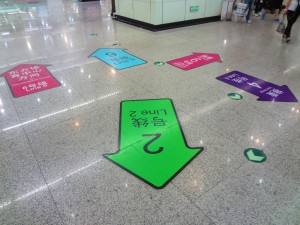
Make the subway floor your best friend! Conveniently colored arrows direct you to the right subway line.
If you need to get out of town, then the train is for you. You need to buy your tickets early because seats fill up fast, but train tickets can be a cheap way to get around China. If you’re all the way in Shanghai, you’re probably going to want to make it to Beijing before long (you can’t leave China without seeing the Great Wall of China, obviously!). I’ll be straightforward with you: these tickets are a little more expensive. A one-way ticket from Shanghai to Beijing by bullet train (the world’s fastest, the one you’ve probably heard about on the news) takes about 4 hours and costs 555 RMB (close to $100). It might sound like a lot, but the less expensive tickets can take up to 14 hours, and some are for standing passengers only. So, if you want to make sure you won’t be on the train for an eternity, and if you don’t want to be standing the entire time, you might want to know what you’re getting into before you buy your ticket. The main train station in Shanghai has an English-speaking counter, so that’s where you’re going to want to go.
There are some modes of transportation I would not suggest in Shanghai, mainly public busses. Although these are the cheapest at only 2 RMB (about $0.33), they are extremely crowded and you as a Westerner might draw unwanted attention. If you’re going out of town, there are usually bus routes, but these can take large amounts of time. If you do decide to take the train, I warn you to get to the train station early! From someone who has run to more than one train in the train station, do not underestimate the time it takes to get to the train station, and remember that the train waits for absolutely no one! Train stations can be big and confusing, so try to get there as early as possible.
Now that you know all of that, the following are a couple vocabulary words that might help make your transportation experience go a little easier:
|
PIN YIN |
ENGLISH PRONUNCIATION |
MEANING |
|
Chuzuche |
Choo-zoo-cha |
Taxi |
|
Feiji |
Fay-gee |
Airplane |
|
Jichang |
Gee-chong |
Airport |
|
Ditie |
Dee-tee-ay |
Subway/Metro |
|
Ditie Zhan |
Dee-tee-ay Jon |
Subway Station |
|
Gongjiaoche |
Gong-gee-ow-cha |
Public Bus |
|
Shifu |
Sh-foo |
Mister/Driver |
|
Zuo Guai |
Zo Gwai |
Turn Left |
|
You Guai |
Yo Gwai |
Turn Right |
|
Ting |
Ting |
Stop |
|
Zenme Qu…? |
Zen-ma Chu…? |
How do I go to…? |
Shanghai, China – Survival Guide, Part 2
If you’re reading this, that means you’re still interested in going to Shanghai–and that I haven’t scared you away, yet. Now that you can say hello and goodbye, you’re probably pretty proud of yourself. Those are important words, but there are some others that might help make your transition a little simpler. Food and transportation are two things that you are going to have to deal with, regardless of what you’re doing in China or how long you are staying. The food you’re used to (name brands, cheese, frozen food) are available in China, but you’ll be amazed how expensive they can be! If it’s imported, it’ll cost you an arm and a leg. If you really, really want that bag of potato chips or frozen dinner, you can get it at a Western grocery store (such as City Shop or Tesco, both popular chains in Shanghai).
But for those who don’t want to spend $10 for a pack of noodles to keep in the freezer, you can either buy Chinese brands (which you have to guess what’s in it–intuition tells you what it should be, but the label and packaging is entirely in Chinese!) or you can spend a lot of your time eating out. Without a car, buying bags of groceries is not as good of an idea as it is back home–remember, you have to carry those bags all the way to your housing, and Shanghai can be oppressively hot! Just make sure your groceries have a logo with a white S over a blue background–that’s the Chinese seal of quality.
For me, it made more sense to eat out. It’s a little more expensive than cooking for yourself, but the food in Shanghai is tasty and a social event. If you’re in China with a group, I’ve found that food is the best way to make friendships and talk to new people. Shanghai has an entire range of food types, but know that they’re probably not the same as the ones you’re used to back home. They have American food, Italian food, and Mexican food, but it all has a bit of a Chinese flair. You’ll get used to it–and miss it as soon as you get home from your trip!
An important topic is Chinese eating etiquette, which means (you guessed it!) chopsticks. They’re devilishly tricky if you’ve never used them before, but you’ll learn quickly… it’s either that or you’ll be hungry for the first couple of days! I can’t explain how to use chopsticks on here, it’s something you have to try for yourself. I suggest practicing before you get to China in order to avoid unwanted chuckling at your expense! As soon as you do learn how to use chopsticks, there are some things you need to know about them. First of all, do not stick your chopsticks directly into a pile of rice and leave them there–that’s offensive because it resembles burning funeral incense. A lot of Chinese restaurants serve their food family style, in which you have a large number of different dishes you share with the rest of the table. This gives you a great opportunity to taste a bunch of dishes you would have never thought to try before. Take what you want, but remember the rest of the table wants to eat, too! Although in America we assume Chinese food usually includes rice, it is important to know that rice and noodles are considered “poor man’s food”–cheaper staple foods that fill you up quickly. Therefore, restaurants or families will serve the more expensive, elaborate, and ornate meat dishes first. Noodles or rice are usually served last to fill you up if you still have room.
Now that you know all of that, it’s time for you to learn some vocabulary! Before you know it, you’ll be eating like a pro.
|
PIN YIN |
ENGLISH PRONUNCIATION |
MEANING |
|
Fandian |
Faun Dee-on |
Restaurant |
|
Mifan |
Me Faun |
Rice |
|
Miantiao |
Me-on Tee-ow |
Noodles |
|
Fuwuyuan |
Foo-oo-yoo-wan |
Waiter/Waitress |
|
Maidan |
My-don |
Bill |
|
Qing |
Ching |
Please |
|
Bu Yao |
Boo Yow |
I Do Not Want |
|
Mei You |
May Yo |
I Do Not Have |
|
Shui |
Shway |
Water |
|
Bing |
Bing |
Ice |
|
Tang |
Tong |
Sugar |
|
Shuiguo |
Shway Gwo |
Fruit |
Shanghai, China – Survival Guide, Part 1
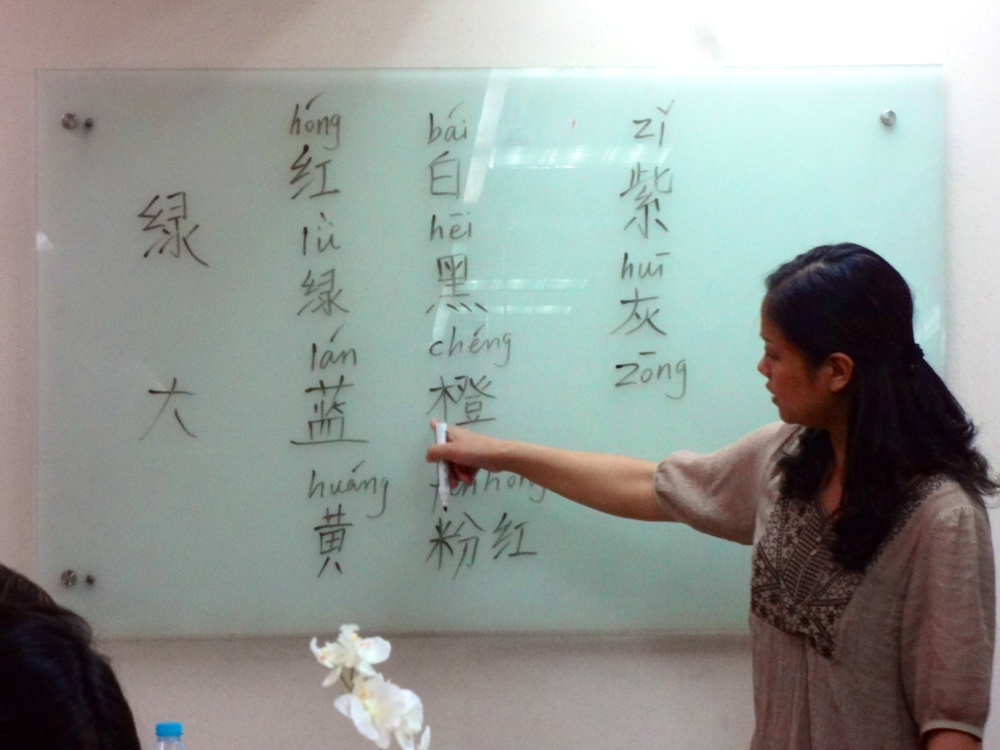
My laoshi (teacher) from Mandarin House teaching us our colors in Chinese!
Greetings from Shanghai, China–the city of inspiration! It has been my extreme pleasure to spend the last two months in this enormous, fast-paced, breathtaking city, the largest proper by population in the world. This was my second time going to a country by myself, and each time I surprised by the intensity of the culture shock–and the shock to emotion.
So, over the course of these next several blog posts, it is my goal to help you manage your transition from America to Shanghai. I loved my time in China, but I understand (and went through) many of the difficulties associated with moving to such a different environment. I hope that my experiences–some triumphs, some travails–will help you with your journey to the Far East.
A great place to start is with some of the words you really need to know before you get to China. I spent my first month in China studying Mandarin Chinese (the language understood by the Chinese people of Shanghai). This is a great start to communicating with the locals and many millions of people in the world’s most populous country. I do have to warn you though: Mandarin is only one of the languages spoken in China–Mandarin and Cantonese are the two predominate languages, but the people in Shanghai speak a variation of Mandarin known as Shanghainese. In addition, a huge number of people you will probably be communicating with in China are expats (short for expatriates, people who have emigrated from their home country and now live in a foreign country). These expats are from all over Asia, Europe, and the Americas, and there are a large number of restaurants and social events geared toward this group.
Regardless of where a person comes from or what their native tongue, I found most people living in Shanghai were able to understand either Mandarin or English–so you’re in luck. Most expats understand some English, but you will need some Mandarin for basic communication with the local Shanghai population. Since you are coming from the University of Louisville, you’re good on the English side of things; the Mandarin, on the other hand, might be a little more difficult!
I won’t lie to you–Mandarin is an incredibly difficult language, especially for native English speakers. Mandarin does not share a language root with English, and therefore grammar and sentence structure is impressively different. It takes about four years of intense study to be certified fluent in Mandarin, but there are a couple words that can help you get around.
|
PIN YIN (Chinese with English letters) |
ENGLISH PRONUNCIATION |
MEANING |
|
Ni Hao |
Nee How |
Hello |
|
Zaijian |
Z-eye Gee-in |
Goodbye/See You Again |
|
Xiexie |
She-ay She-ay |
Thank You |
|
Bu Keqi |
Boo Ke-chee |
You’re Welcome |
|
Hao |
How |
Good/Fine/Okay |
|
Kuai |
Kw-eye |
Cash/Money |
Korea Love
Seoul, South Korea – I cannot even begin to express my love for this place! The overall journey began with the 14 hour flight of course…it in itself was an experience of a lifetime into the Asian culture! Asiana Airlines is simply the best flight ever. The first thing that intrigued me was the professional and feminine attire of the flight attendants. It was also Asian inspired from color to style. The next great thing was the three rows of seating. The sight of 95% Asian and 5% other cultures of people on a huge international plane was amazing. On the flight, there were many great “gifts”. We were given slippers, nice blankets, pillows, toothbrush/toothpaste, mouthwash, and three GREAT meals. I made friends on the plane as well, that was a plus. This was just the flight!
My first night in Korea was busy. We unpacked and immediately went to hang out with other ISS students we met at the airport. The city of Seoul is full of lights, people, action, and buildings! It is truly a place for the young and able. LoL. The story of my short living in Korea only gets better. 🙂
Back Home
Well we are back home in the states and my first meal was a burger and fries. I loved the trip, although I would have changed a few things if I did it again. The mainly find and way to make more native friends.
Of all the places we went the Great Wall of China was the most incredible thing that I have ever seen. Not only in China but in my 21 years of life thus far. Chinese is much harder than I thought it would be, even though I knew it would be very hard. It’s going to take a few more years of studying for me get where I would like to be but I liked it so I’m willing to put in the effort.
On our last day in China we went to our favorite dumpling place again. The owner showed us how she makes her dumplings so I’m excited about trying to make them some time in the near future. I must say the one of the downsides to such great food is that I don’t know if I will ever enjoy Chinese food here at home as much as I did before.
I am already looking forward to my next trip abroad. This was just such a great experience. Anyone who can should study abroad. You will not regret having that life experience and you will have a blast.
Beijing China
Friday May 25th
I can’t believe it has only been a week. I have already learned so much Chinese (what I retained is a different story though). I have two tutors that tutor me for 16 hours in the week. So I have been moving really fast and have covered so many new words I am now having trouble sorting through them all. Next week I have my first dictation in which I’m supposed to listen and then write what is said. I am supposed to write in characters but as of today I can barely read a sentence without by handy vocab book.
On the other hand, I have been having a really good time so far. There is a dumpling place that has the best steamed dumplings ever!! You can get anything you think of in them (egg and garlic, lamb and radish, pork and corn, and vegies just to name some of the ones I’ve tried). Today I tried noodles made from potatoes and tomorrow we get to try Beijing’s famous roast duck. It will be a while before I will be able to eat Chinese food in the states.
Beijing China
Thursday May 17th
Well I had my first Chinese class today and I learned a lot. Now I will have to study my butt off so that I can remember it all. I have four hours of class each day and it’s just me in the class which has its pros and cons. I like my fist teacher so far and it seems like we will move very quickly so I will need to really pay attention. I want to get as much out of this trip as possible.
On the other hand we have had so much great food and at such a cheap price. Also people like to eat family style here and the waiters get really mad when people at the same table try to pay separately. So we have been trying to avoid doing that. Even when we do we have to figure out the change and everything ourselves so that we can pay the waiter in a lump sum.
This campus has so many students from all over the place. I just met some more students from UofL which was nice.
This weekend we are going to the Great Wall which I am really looking forward too. Well I’m off to review all of the stuff I learned today so I hope everyone in enjoying their summer J
